Morton’s Neuroma or Intermetatarsal Bursitis—A Prospective Diagnostic Study of Intermetatarsal Pain
Abstract
1. Introduction
2. Materials and Methods
3. Results
- Among patients with intermetatarsal pain, 53.8% had IMB and 19.2% had MN on MRI;
- US identified intermetatarsal pathology in all but one patient, but the differentiation is challenging;
- A normal intermetatarsal bursa is visible on US;
- A hypoechoic process between the metatarsal heads on US is not always pathological and should always be interpreted in correlation with the symptoms;
- Patients with MN have more severe pain compared to patients with IMB;
- There are no differences in the symptoms of MN and IMB.
3.1. Participant Characteristics
3.2. Imaging Results
3.3. Differences Between MN and IMB
4. Discussion
5. Conclusions
Supplementary Materials
Author Contributions
Funding
Institutional Review Board Statement
Informed Consent Statement
Data Availability Statement
Acknowledgments
Conflicts of Interest
Abbreviations
| MN | Morton’s neuroma |
| IMB | Intermetatarsal bursitis |
| MRI | Magnetic resonance imaging |
| US | Ultrasound |
| DTML | Deep transverse metatarsal ligament |
References
- Matthews, B.G.; Thomson, C.E.; Harding, M.P.; McKinley, J.C.; Ware, R.S. Treatments for Morton’s neuroma. Cochrane Database Syst Rev. 2024, 2, Cd014687. [Google Scholar] [PubMed]
- Jain, S.; Mannan, K. The diagnosis and management of Morton’s neuroma: A literature review. Foot Ankle Spec. 2013, 6, 307–317. [Google Scholar] [CrossRef] [PubMed]
- Bossley, C.; Cairney, P. The intermetatarsophalangeal bursa--its significance in Morton’s metatarsalgia. J. Bone Jt. Surgery. Br. Vol. 1980, 62-B, 184–187. [Google Scholar] [CrossRef] [PubMed]
- Ganguly, A.; Warner, J.; Aniq, H. Central metatarsalgia and walking on pebbles: Beyond morton neuroma. Am. J. Roentgenol. 2018, 210, 821–833. [Google Scholar] [CrossRef]
- Franco, H.; Pagliaro, T.; Sparti, C.; Walsh, H.J. Comparing Clinical Examination and Radiological Evaluation in the Preoperative Diagnosis and Location of Symptomatic Interdigital (Morton’s) Neuroma. J. Foot Ankle Surg. 2023, 62, 883–887. [Google Scholar] [CrossRef]
- Dando, C.; Cherry, L.; Jones, L.; Bowen, C. The clinical diagnosis of symptomatic forefoot neuroma in the general population: A Delphi consensus study. J. Foot Ankle Res. 2017, 10, 59. [Google Scholar] [CrossRef]
- Larsen, S.B.; Søgaard, S.B.; Nielsen, M.B.; Torp-Pedersen, S.T. Diagnostic Considerations of Intermetatarsal Bursitis: A Systematic Review. Diagnostics 2023, 13, 211. [Google Scholar] [CrossRef]
- Albano, D.; Bonifacini, C.; Zannoni, S.; Bernareggi, S.; Messina, C.; Galia, M.; Sconfienza, L.M. Plantar forefoot pain: Ultrasound findings before and after treatment with custom-made foot orthoses. Radiol Med. 2021, 126, 963–970. [Google Scholar] [CrossRef]
- Fenech, M. Sonographic anatomy and technique to image the plantar digital nerves and aid identification of a Morton’s neuroma. Ultrasound 2024, 32, 114–126. [Google Scholar] [CrossRef]
- Zanetti, M.; Weishaupt, D. MR imaging of the forefoot: Morton neuroma and differential diagnoses. Semin. Musculoskelet. Radiol. 2005, 9, 175–186. [Google Scholar] [CrossRef]
- Albtoush, O.M.; Xenitidis, T.; Horger, M. Intermetatarsal bursitis as first disease manifestation in different rheumatological disorders and related MR-imaging findings. Rheumatol. Int. 2019, 39, 2129–2136. [Google Scholar] [CrossRef] [PubMed]
- Iagnocco, A.; Coari, G.; Palombi, G.; Valesini, G. Sonography in the study of metatarsalgia. J. Rheumatol. 2001, 28, 1338–1340. [Google Scholar] [PubMed]
- Sconfienza, L.M.; Albano, D.; Allen, G.; Bazzocchi, A.; Bignotti, B.; Chianca, V.; de Castro, F.F.; Drakonaki, E.E.; Gallardo, E.; Gielen, J.; et al. Clinical indications for musculoskeletal ultrasound updated in 2017 by European Society of Musculoskeletal Radiology (ESSR) consensus. Eur. Radiol. 2018, 28, 5338–5351. [Google Scholar] [CrossRef]
- Xu, Z.; Duan, X.; Yu, X.; Wang, H.; Dong, X.; Xiang, Z. The accuracy of ultrasonography and magnetic resonance imaging for the diagnosis of Morton’s neuroma: A systematic review. Clin. Radiol. 2015, 70, 351–358. [Google Scholar] [CrossRef]
- Bignotti, B.; Signori, A.; Sormani, M.P.; Molfetta, L.; Martinoli, C.; Tagliafico, A. Ultrasound versus magnetic resonance imaging for Morton neuroma: Systematic review and meta-analysis. Eur. Radiol. 2015, 25, 2254–2262. [Google Scholar] [CrossRef]
- Lu, V.M.; Puffer, R.C.; Everson, M.C.; Gilder, H.E.; Burks, S.S.; Spinner, R.J. Treating Morton’s neuroma by injection, neurolysis, or neurectomy: A systematic review and meta-analysis of pain and satisfaction outcomes. Acta Neurochir. 2020, 163, 531–543. [Google Scholar] [CrossRef]
- Thomson, C.E.; Beggs, I.; Martin, D.J.; McMillan, D.; Edwards, R.T.; Russell, D.; Yeo, S.T.; Russell, I.T.; Gibson, J.N. Methylprednisolone injections for the treatment of Morton neuroma: A patient-blinded randomized trial. J. Bone Jt. Surg. Am. 2013, 95, 790–798, s1. [Google Scholar] [CrossRef]
- Lizano-Díez, X.; Ginés-Cespedosa, A.; Alentorn-Geli, E.; Pérez-Prieto, D.; González-Lucena, G.; Gamba, C.; de Zabala, S.; Solano-López, A.; Rigol-Ramón, P. Corticosteroid Injection for the Treatment of Morton’s Neuroma: A Prospective, Double-Blinded, Randomized, Placebo-Controlled Trial. Foot Ankle Int. 2017, 38, 944–951. [Google Scholar] [CrossRef]
- Cöster, M.C.; Nilsdotter, A.; Brudin, L.; Bremander, A. Minimally important change, measurement error, and responsiveness for the Self-Reported Foot and Ankle Score. Acta Orthop. 2017, 88, 300–304. [Google Scholar] [CrossRef]
- Bianchi, S. Practical US of the forefoot. J. Ultrasound 2014, 17, 151–164. [Google Scholar] [CrossRef]
- Read, J.W.; Noakes, J.B.; Kerr, D.; Crichton, K.J.; Slater, H.K.; Bonar, F. Morton’s metatarsalgia: Sonographic findings and correlated histopathology. Foot Ankle Int. 1999, 20, 153–161. [Google Scholar] [CrossRef] [PubMed]
- Hammer, H.; Kvien, T.; Terslev, L. Intermetatarsal Bursitis Is Prevalent in Patients with Established Rheumatoid Arthritis and Is Associated with Anti-CCP and RF. Arthritis Rheumatol. 2019, 71, 3. [Google Scholar]
- Dakkak, Y.J.; Boer, A.C.; Boeters, D.M.; Niemantsverdriet, E.; Reijnierse, M.; Mil, A.H.M.v.d.H.-V. The relation between physical joint examination and MRI-depicted inflammation of metatarsophalangeal joints in early arthritis. Arthritis Res. Ther. 2020, 22, 1–9. [Google Scholar] [CrossRef]
- Zanetti, M.; Ledermann, T.; Zollinger, H.; Hodler, J.; Zanetti, T.L.M.; Bencardino, J.; Rosenberg, Z.S.; Beltran, J.; Liu, X.; Marty-Delfaut, E.; et al. Efficacy of MR imaging in patients suspected of having Morton’s neuroma. Am. J. Roentgenol. 1997, 168, 529–532. [Google Scholar] [CrossRef]
- Harris, P.A.; Taylor, R.; Minor, B.L.; Elliott, V.; Fernandez, M.; O’Neal, L.; McLeod, L.; Delacqua, G.; Delacqua, F.; Kirby, J.; et al. The REDCap consortium: Building an international community of software platform partners. J. Biomed. Inform. 2019, 95, 103208. [Google Scholar] [CrossRef]
- Harris, P.A.; Taylor, R.; Thielke, R.; Payne, J.; Gonzalez, N.; Conde, J.G. Research electronic data capture (REDCap)—A metadata-driven methodology and workflow process for providing translational research informatics support. J. Biomed. Inform. 2009, 42, 377–381. [Google Scholar] [CrossRef]
- Hassouna, H.; Singh, D.; Taylor, H.; Johnson, S. Ultrasound guided steroid injection in the treatment of interdigital neuralgia. Acta Orthop. Belg. 2007, 73, 224–229. [Google Scholar]
- Cohen, S.L.; Miller, T.T.; Ellis, S.J.; Roberts, M.M.; DiCarlo, E.F. Sonography of Morton Neuromas: What Are We Really Looking At? J. Ultrasound Med. 2016, 35, 2191–2195. [Google Scholar] [CrossRef]
- Reijnierse, M.; Griffith, J.F. High-resolution ultrasound and MRI in the evaluation of the forefoot and midfoot. J. Ultrason. 2023, 23, 249–269. [Google Scholar] [CrossRef]
- Koski, J.M. Ultrasound detection of plantar bursitis of the forefoot in patients with early rheumatoid arthritis. J. Rheumatol. 1998, 25, 229–230. [Google Scholar]
- Redd, R.A.; Peters, V.J.; Emery, S.F.; Branch, H.M.; Rifkin, M.D. Morton neuroma: Sonographic evaluation. Radiology 1989, 171, 415–417. [Google Scholar] [CrossRef] [PubMed]
- Chen, X.; Zhou, G.; Xue, H.; Wang, R.; Bird, S.; Sun, D.; Cui, L. High-Resolution Ultrasound of the Forefoot and Common Pathologies. Diagnostics 2022, 12, 1541. [Google Scholar] [CrossRef] [PubMed]
- Zanetti, M.; Strehle, J.K.; Zollinger, H.; Hodler, J. Morton neuroma and fluid in the intermetatarsal bursae on MR images of 70 asymptomatic volunteers. Radiology 1997, 203, 516–520. [Google Scholar] [CrossRef]
- Chauveaux, D.; Le Huec, J.C.; Midy, D. The supra-transverse intermetatarsocapital bursa: A description and its relation to painful syndromes of the forefoot. Surg. Radiol. Anat. 1987, 9, 13–18. [Google Scholar] [CrossRef]
- Theumann, N.H.; Pfirrmann, C.W.A.; Chung, C.B.; Mohana-Borges, A.V.R.; Haghighi, P.; Trudell, D.J.; Resnick, D. Intermetatarsal spaces: Analysis with MR bursography, anatomic correlation, and histopathology in cadavers. Radiology 2001, 221, 478–484. [Google Scholar] [CrossRef]
- Kim, J.-Y.; Choi, J.H.; Park, J.; Wang, J.; Lee, I. An anatomical study of Morton’s interdigital neuroma: The relationship between the occurring site and the deep transverse metatarsal ligament (DTML). Foot Ankle Int. 2007, 28, 1007–1010. [Google Scholar] [CrossRef]
- Zanetti, M.; Strehle, J.K.; Kundert, H.-P.; Zollinger, H.; Hodler, J. Morton neuroma: Effect of MR imaging findings on diagnostic thinking and therapeutic decisions. Radiology 1999, 213, 583–588. [Google Scholar] [CrossRef]
- Hassouna, H.; Singh, D. Morton’s metatarsalgia: Pathogenesis, aetiology and current management. Acta Orthop. Belg. 2005, 71, 646–655. [Google Scholar]
- Mak, M.; Chowdhury, R.; Johnson, R. Morton’s neuroma: Review of anatomy, pathomechanism, and imaging. Clin. Radiol. 2021, 76, 235.e15–235.e23. [Google Scholar] [CrossRef]
- Samaila, E.; Colò, G.; Rava, A.; Negri, S.; Valentini, R.; Felli, L.; Magnan, B. Effectiveness of corticosteroid injections in Civinini–Morton’s Syndrome: A systematic review. Foot Ankle Surg. 2020, 27, 357–365. [Google Scholar] [CrossRef]
- Pitcher, M.; Moulson, A.; Pitcher, D.; Herbland, A.; Cert, G.; Cairns, M.C. Diagnostic Accuracy of Subjective Features and Physical Examination Tests for Morton Neuroma: A Systematic Review. Foot Ankle Orthop. 2024, 9, 24730114241291055. [Google Scholar] [CrossRef] [PubMed]
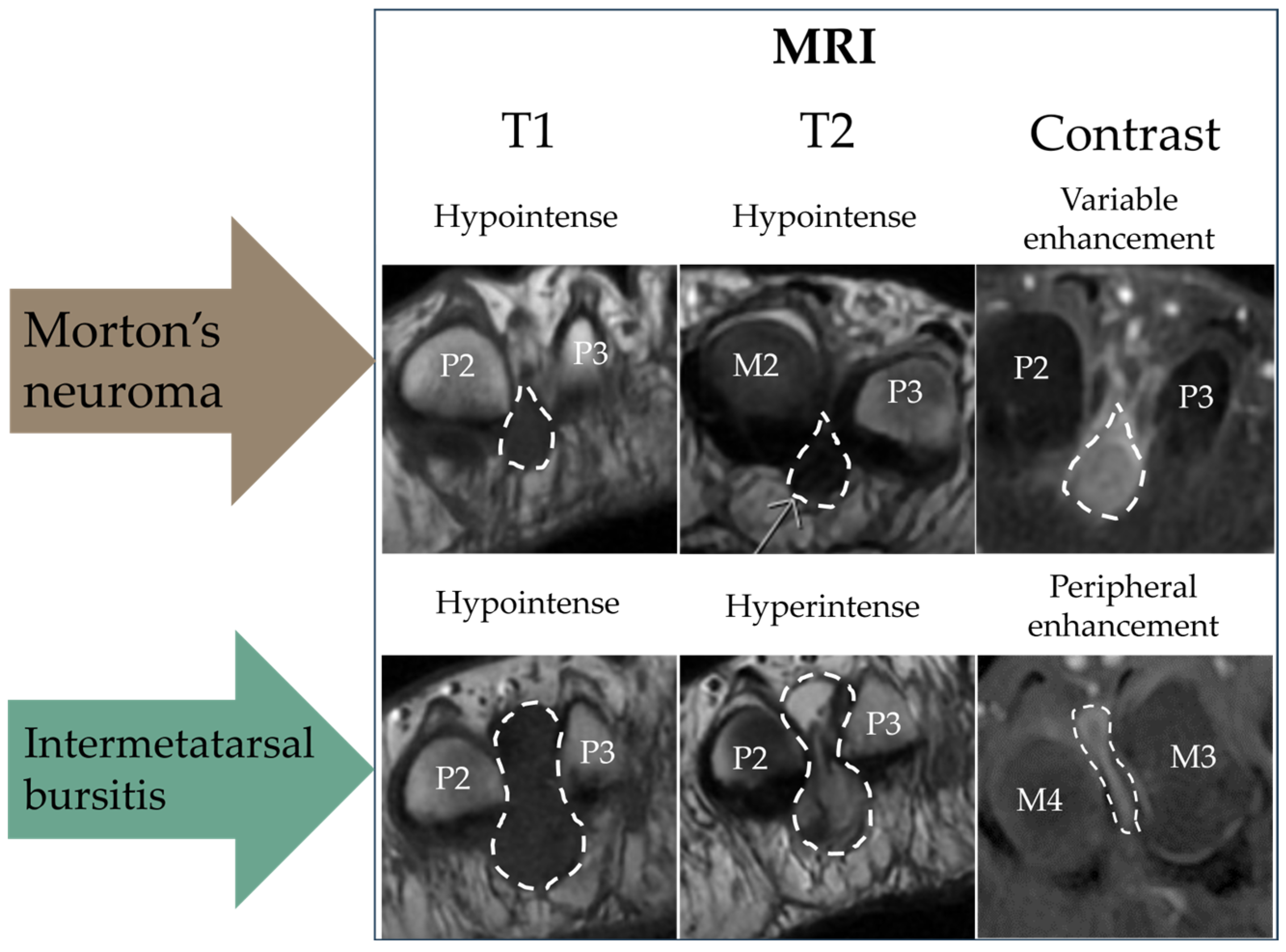
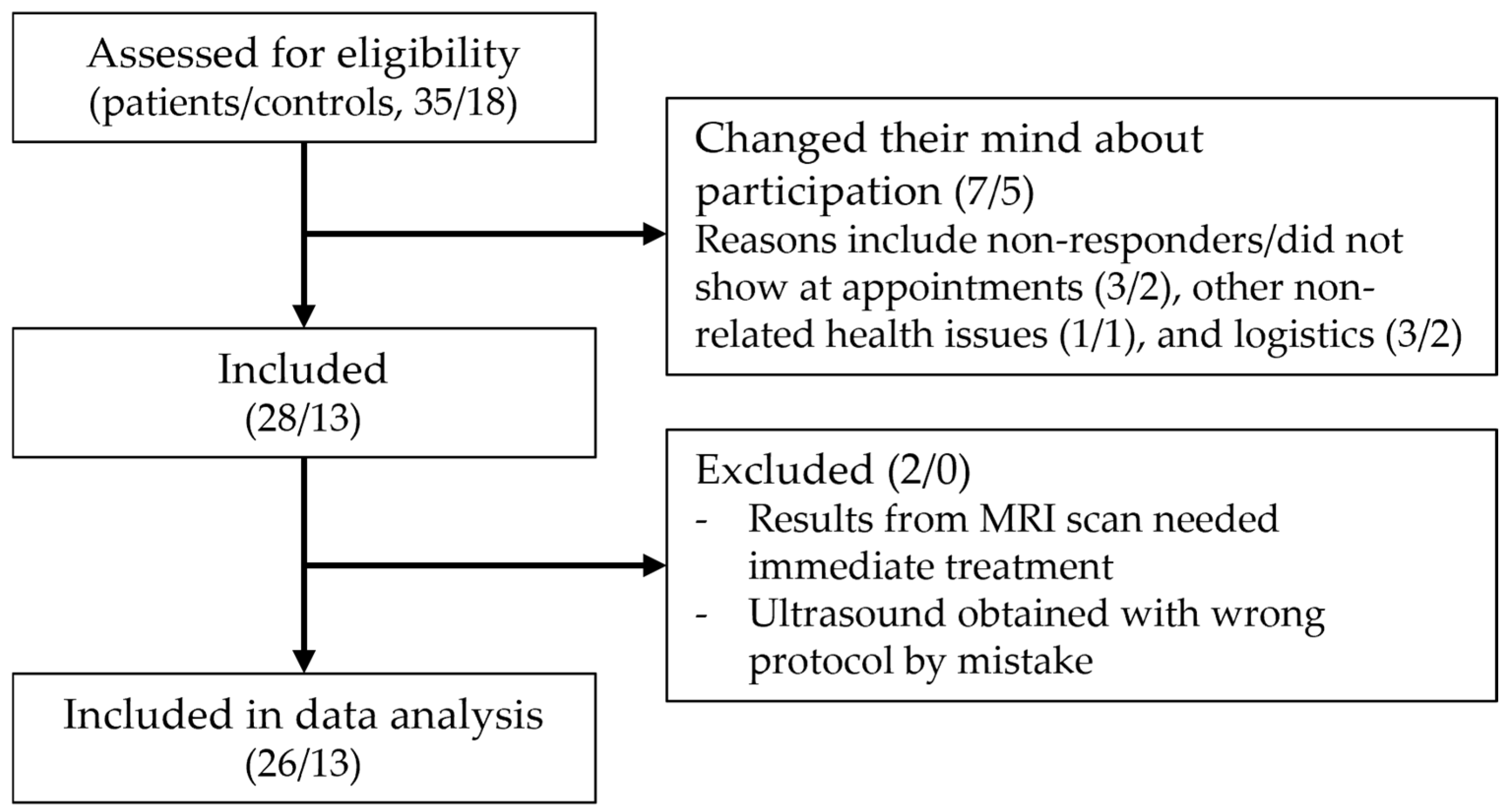
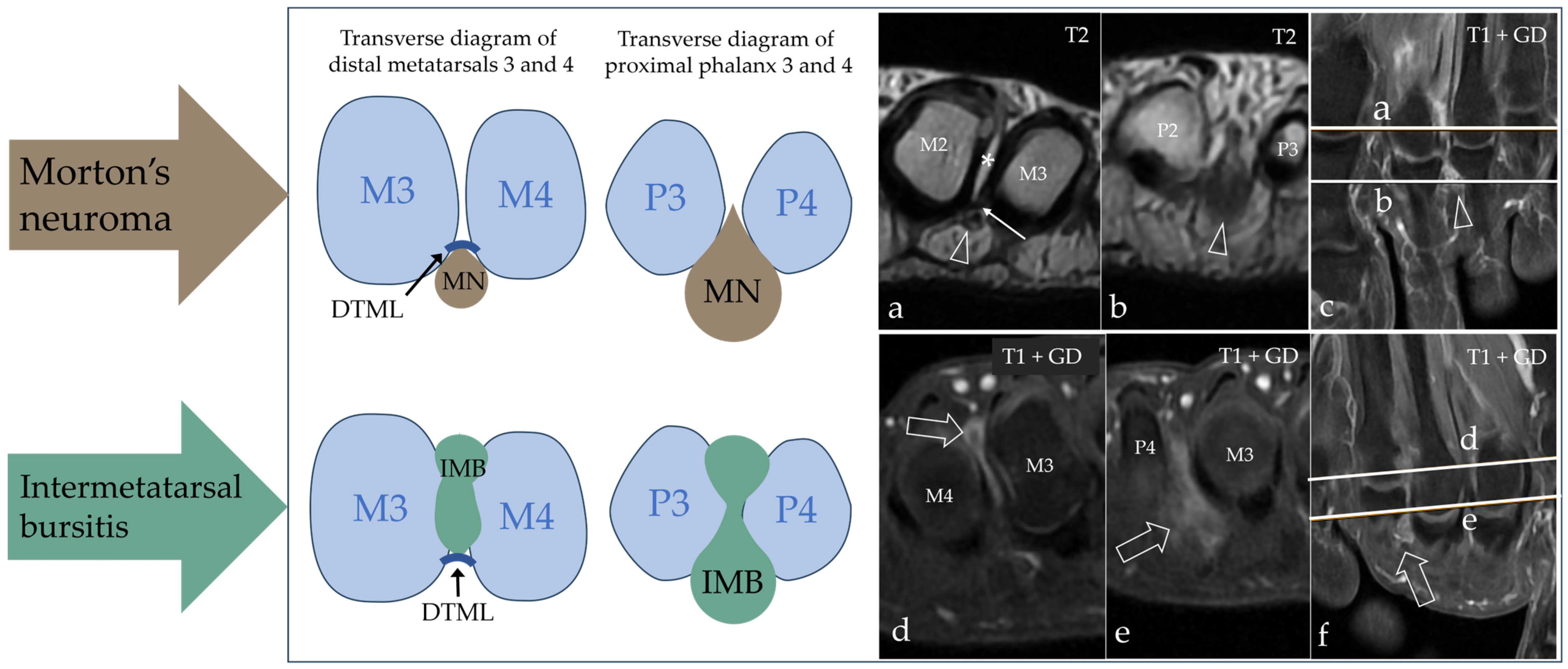
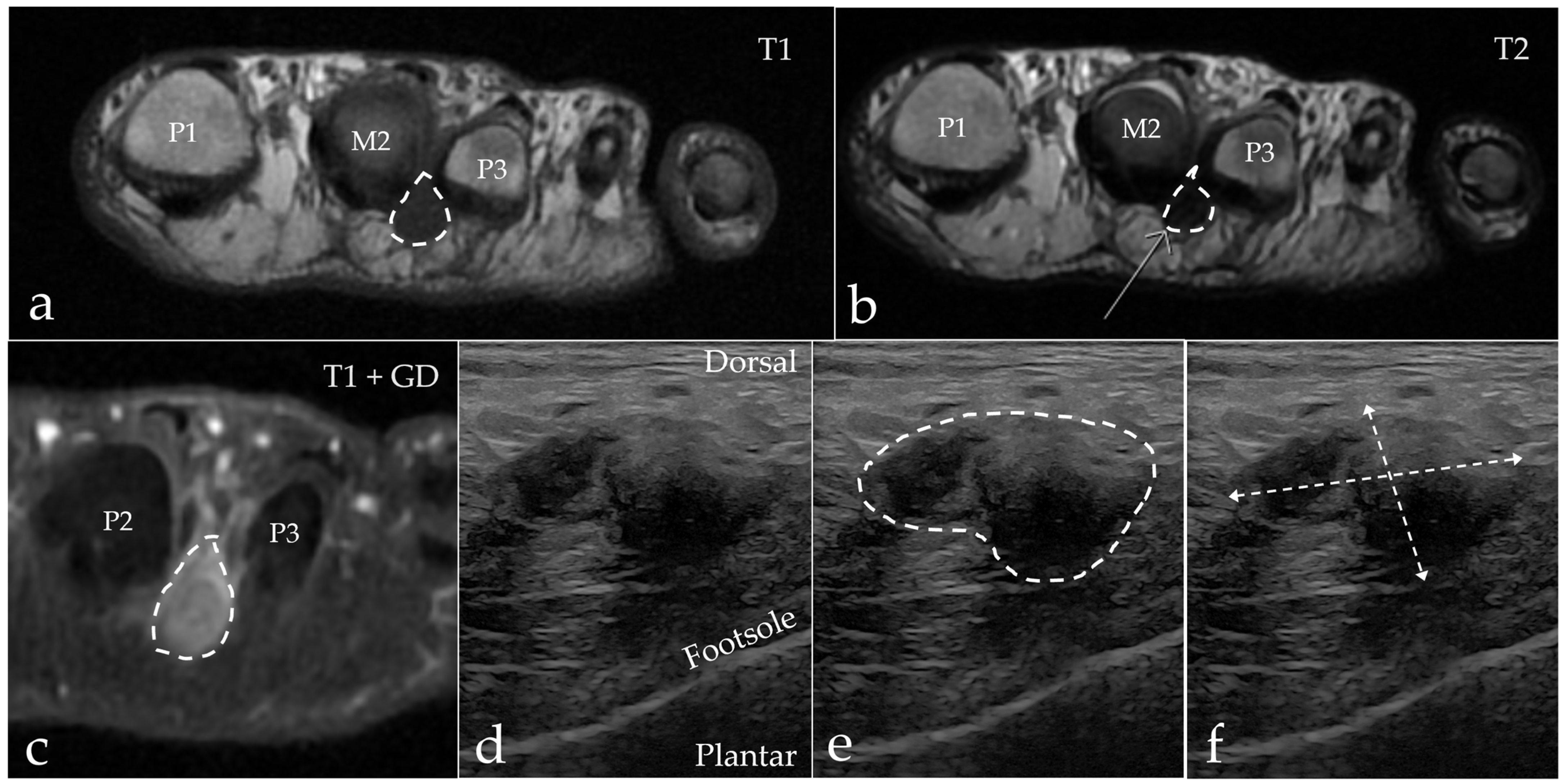
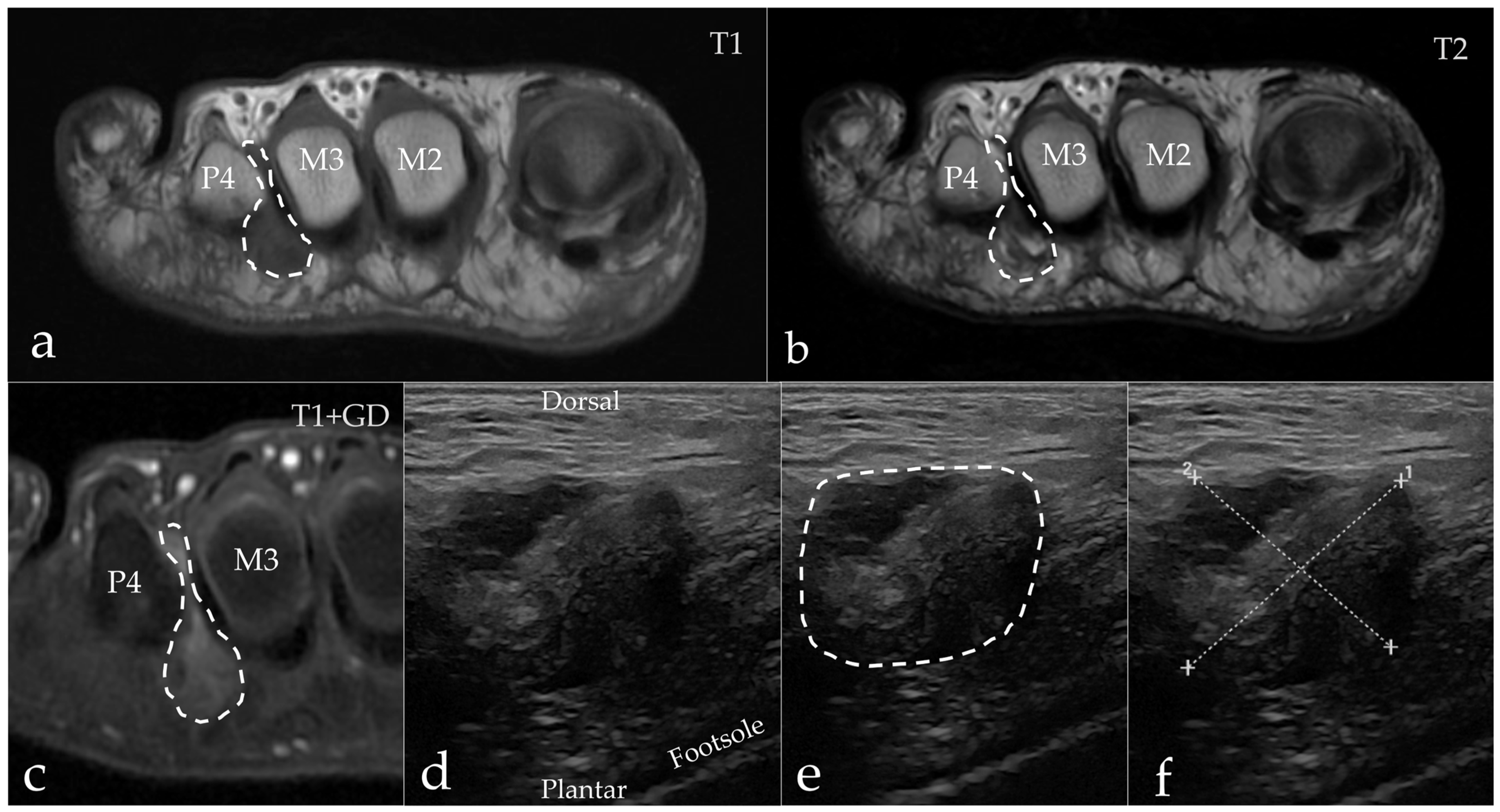
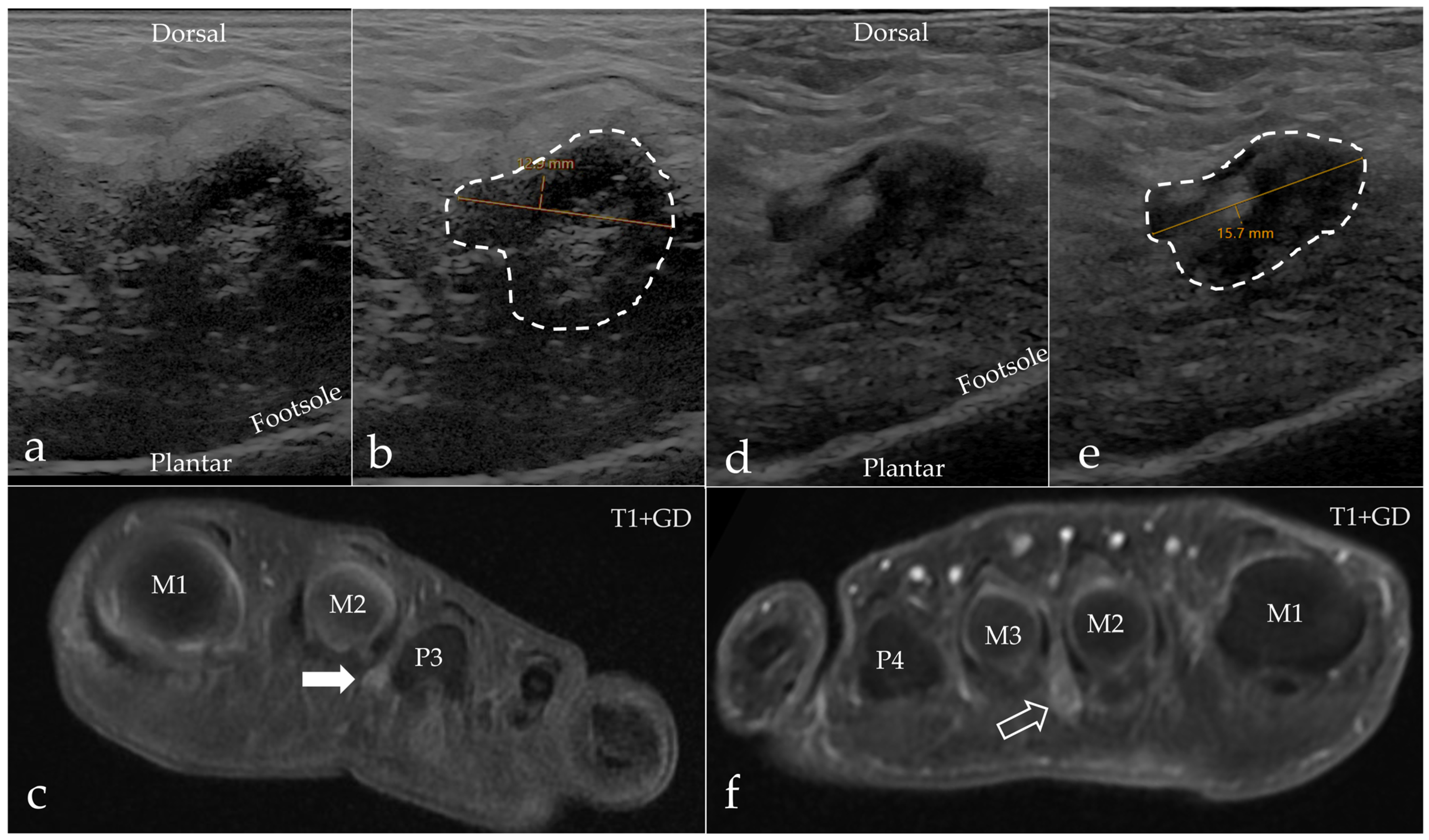
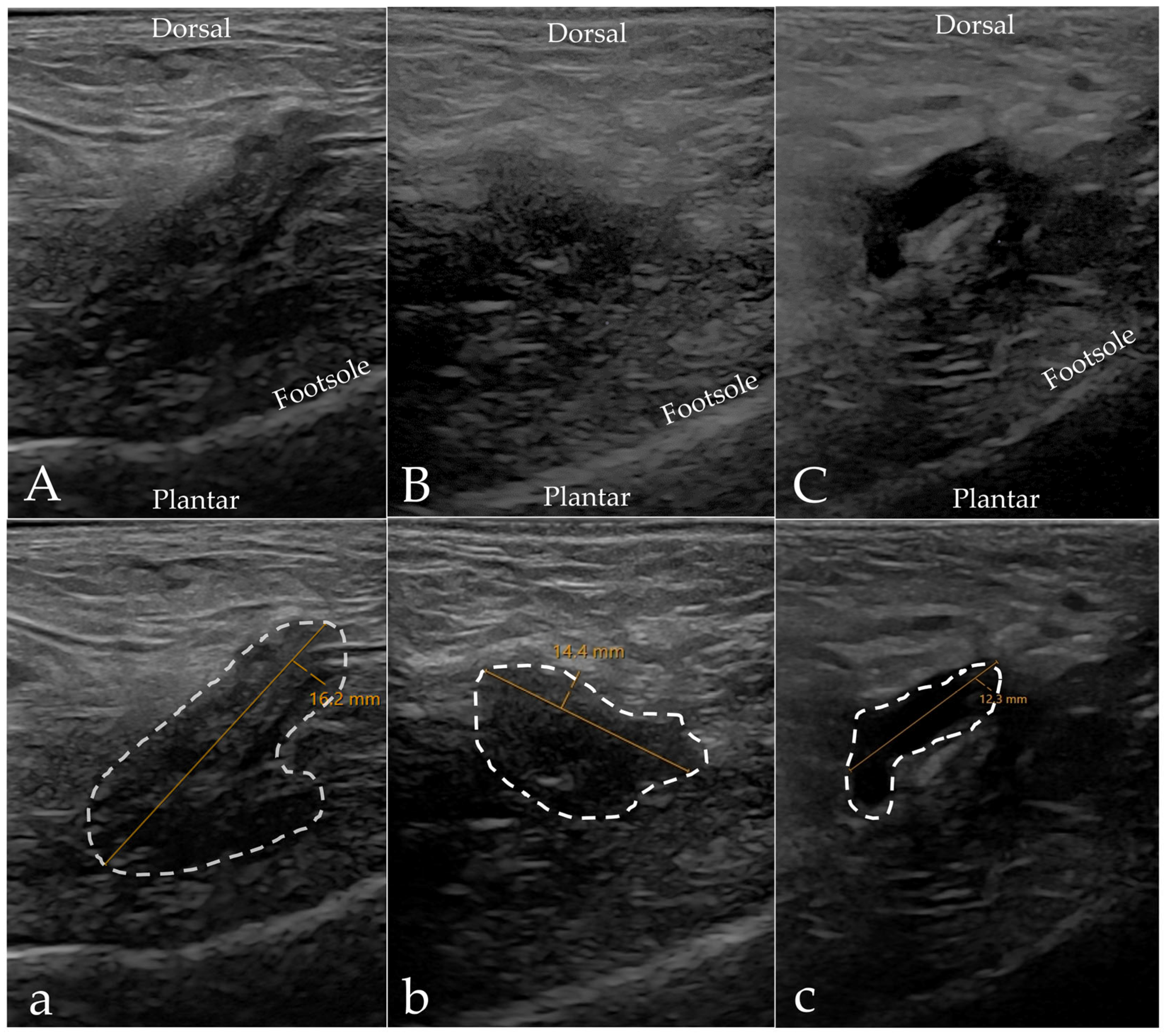


| Mean Pain Duration | Affected Foot R/L | Affected Web Space (Subjective) | Affected Sensation in Adjacent Toes | Triggering Trauma | Mean VAS Score at Inclusion |
|---|---|---|---|---|---|
| 29 months (range 2–96) | 16:10 | 2nd: 7 (27%) 3rd: 6 (23%) 2nd + 3rd: 8 (31%) Non-specific: 5 (19%) | 17 (65%) | 5 (19%) | 67 (range 20–100) * |
| Patients | Controls | |||
|---|---|---|---|---|
| MRI | US | MRI | US | |
| Intermetatarsal bursitis | 53.9% (14/26) | 96.2% (25/26) | 23.1% (3/13) | 30.8% (4/13) |
| Morton’s neuroma | 19.2% (5/26) | 0% (0/26) | 7.7% (1/13) | 0% (0/13) |
| Normal scan | 19.2% (5/26) | 3.8% (1/26) | 61.5% (8/13) | 69.2% (9/13) |
| Other | 7.7% (2/26) | 0% (0/26) | 7.7% (1/13) | 0% (0/13) |
Disclaimer/Publisher’s Note: The statements, opinions and data contained in all publications are solely those of the individual author(s) and contributor(s) and not of MDPI and/or the editor(s). MDPI and/or the editor(s) disclaim responsibility for any injury to people or property resulting from any ideas, methods, instructions or products referred to in the content. |
© 2025 by the authors. Licensee MDPI, Basel, Switzerland. This article is an open access article distributed under the terms and conditions of the Creative Commons Attribution (CC BY) license (https://creativecommons.org/licenses/by/4.0/).
Share and Cite
Larsen, S.B.; Offersen, C.M.; Dyrberg, E.; Johansen, J.K.; Lange, N.B.; Bech, B.H.; Nielsen, M.B.; Torp-Pedersen, S.T. Morton’s Neuroma or Intermetatarsal Bursitis—A Prospective Diagnostic Study of Intermetatarsal Pain. Diagnostics 2025, 15, 1339. https://doi.org/10.3390/diagnostics15111339
Larsen SB, Offersen CM, Dyrberg E, Johansen JK, Lange NB, Bech BH, Nielsen MB, Torp-Pedersen ST. Morton’s Neuroma or Intermetatarsal Bursitis—A Prospective Diagnostic Study of Intermetatarsal Pain. Diagnostics. 2025; 15(11):1339. https://doi.org/10.3390/diagnostics15111339
Chicago/Turabian StyleLarsen, Sif Binder, Cecilie Mørck Offersen, Eva Dyrberg, Jens Kurt Johansen, Naja Bjørslev Lange, Birthe Højlund Bech, Michael Bachmann Nielsen, and Søren Tobias Torp-Pedersen. 2025. "Morton’s Neuroma or Intermetatarsal Bursitis—A Prospective Diagnostic Study of Intermetatarsal Pain" Diagnostics 15, no. 11: 1339. https://doi.org/10.3390/diagnostics15111339
APA StyleLarsen, S. B., Offersen, C. M., Dyrberg, E., Johansen, J. K., Lange, N. B., Bech, B. H., Nielsen, M. B., & Torp-Pedersen, S. T. (2025). Morton’s Neuroma or Intermetatarsal Bursitis—A Prospective Diagnostic Study of Intermetatarsal Pain. Diagnostics, 15(11), 1339. https://doi.org/10.3390/diagnostics15111339








